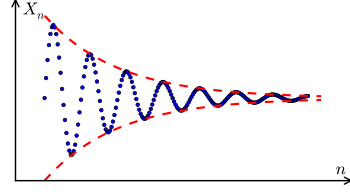Metric spaces
Metric spaces[edit]
Definition[edit]
A point of the metric space is the limit of the sequence if:
- For each real number , there is a natural number such that, for every natural number , we have .
Symbolically, this is:
- .
This coincides with the definition given for real numbers when and .
Properties[edit]
- When it exists, the limit of a sequence is unique, as distinct points are separated by some positive distance, so for less than half this distance, sequence terms cannot be within a distance of both points.
- For any continuous function f, if exists, then . In fact, a function f is continuous if and only if it preserves the limits of sequences.
Cauchy sequences[edit]
A Cauchy sequence is a sequence whose terms ultimately become arbitrarily close together, after sufficiently many initial terms have been discarded. The notion of a Cauchy sequence is important in the study of sequences in metric spaces, and, in particular, in real analysis. One particularly important result in real analysis is the Cauchy criterion for convergence of sequences: a sequence of real numbers is convergent if and only if it is a Cauchy sequence. This remains true in other complete metric spaces.
Topological spaces[edit]
Definition[edit]
A point of the topological space is a limit or limit point[7][8] of the sequence if:
- For every neighbourhood of , there exists some such that for every , we have .[9]
This coincides with the definition given for metric spaces, if is a metric space and is the topology generated by .
A limit of a sequence of points in a topological space is a special case of a limit of a function: the domain is in the space , with the induced topology of the affinely extended real number system, the range is , and the function argument tends to , which in this space is a limit point of .
Properties[edit]
In a Hausdorff space, limits of sequences are unique whenever they exist. Note that this need not be the case in non-Hausdorff spaces; in particular, if two points and are topologically indistinguishable, then any sequence that converges to must converge to and vice versa.
Hyperreal numbers[edit]
The definition of the limit using the hyperreal numbers formalizes the intuition that for a "very large" value of the index, the corresponding term is "very close" to the limit. More precisely, a real sequence tends to L if for every infinite hypernatural H, the term is infinitely close to L (i.e., the difference is infinitesimal). Equivalently, L is the standard part of :
- .
Thus, the limit can be defined by the formula
- .
where the limit exists if and only if the righthand side is independent of the choice of an infinite H.

































Comments
Post a Comment